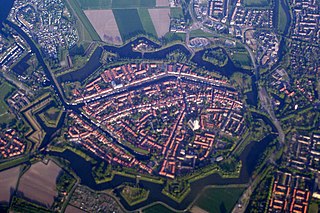
Brielle, also called Den Briel in Dutch and Brill in English, is a town and historic seaport in the western Netherlands, in the province of South Holland, on the north side of the island of Voorne-Putten, at the mouth of the New Maas. The former municipality covered an area of 31.14 km2 (12.02 sq mi) of which 3.59 km2 (1.39 sq mi) was water. In 2021 its population was 17,439.

Geuzen was a name assumed by the confederacy of Calvinist Dutch nobles, who from 1566 opposed Spanish rule in the Netherlands. The most successful group of them operated at sea, and so were called Watergeuzen. In the Eighty Years' War, the Capture of Brielle by the Watergeuzen in 1572 provided the first foothold on land for the rebels, who would conquer the northern Netherlands and establish an independent Dutch Republic. They can be considered either as privateers or pirates, depending on the circumstances or motivations.

Louis of Nassau was the third son of William I, Count of Nassau-Siegen and Juliana of Stolberg, and the younger brother of Prince William of Orange Nassau.
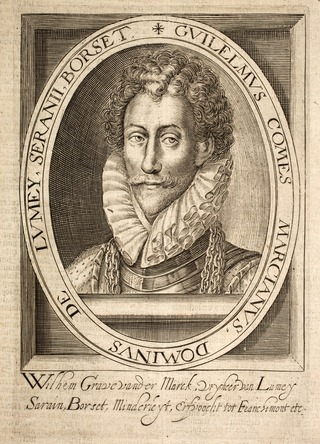
William II de la Marck was the Lord of Lumey and initially admiral of the Watergeuzen, the so-called 'sea beggars' who fought in the Eighty Years' War (1568–1648), together with among others William the Silent, Prince of Orange-Nassau. He was the great-grandson of an equally notorious character, baron William de la Marck, nicknamed the "wild boar of the Ardennes".

Henry (Hendrik), Lord of Bréderode, also styled Count of Brederode, was a member of the Dutch noble family Van Brederode. He was the leader of the allied Dutch nobles, the so-called Compromise of Nobles of 1566 and the Geuzen at the beginning of the Eighty Years' War. Van Brederode was named the "Grote Geus" or the "Big Beggar".
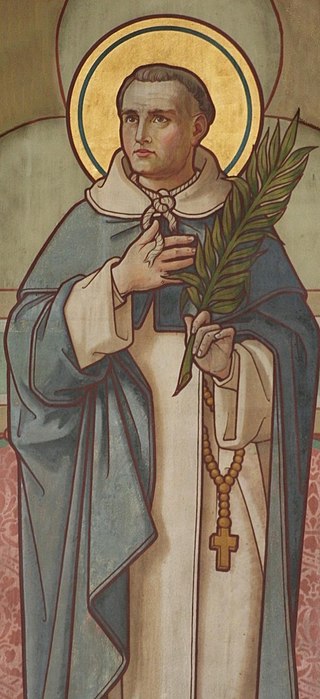
John of Cologne, was a friar and priest of the Dominican Order, born in the Electorate of Cologne, part of modern Germany. He later became a parish priest of Hoornaar, in the Spanish Netherlands. He was executed for his faith in 1572 and has been declared a martyr and saint by the Catholic Church.
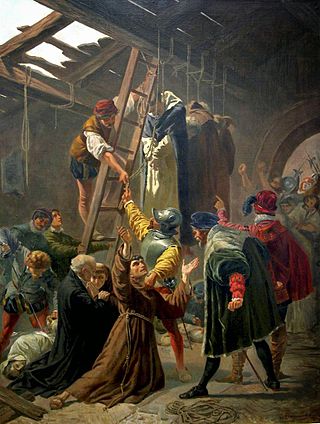
The Martyrs of Gorkum were a group of 19 Dutch Catholic clerics, secular and religious, who were hanged on 9 July 1572 in the town of Brielle by militant Dutch Calvinists during the 16th-century religious wars—specifically, the Dutch Revolt against Spanish rule, which developed into the Eighty Years' War.

Cornelis de Graeff, often named Polsbroek or de heer van (lord) Polsbroek during his lifetime was an influential regent and burgomaster (mayor) of Amsterdam, statesman and diplomat of Holland and the Republic of the United Netherlands at the height of the Dutch Golden Age.

De Graeff is an old Dutch patrician and noble family,
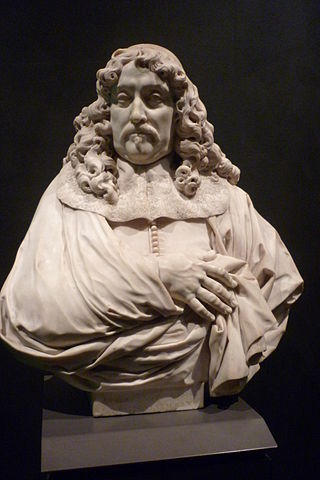
Andries de Graeff was a regent and burgomaster (mayor) of Amsterdam and leading Dutch statesman during the Golden Age.

Dirck Jansz Graeff, also Diederik Jansz Graeff, Lord of the manors Valckeveen and Vredenhof, was a patrician, wholesaler, shipowner, politician and large landowner. He became an important figure of the Protestant Reformation, member of the Reformed Church, supporter of the Geuzen and the Protestant-minded community of wholesale merchants, and a confidant of William I of Orange. Graeff was the founder of a regent dynasty of the Dutch Golden Age and the short time of the First Stadtholderless Period that retained power and influence for centuries and produced a number of ministers. He was the first Burgomaster of Amsterdam from the De Graeff family.

Lenaert Jansz de Graeff, also Lena(e)rt Jansz Graeff, Leendert de Graeff and Leonhard de Graeff belonged to the powerful Amsterdam patriciate. He was one of the leaders of the Protestant Reformation in Amsterdam, a friend of Henry, Count of Bréderode, the "Grote Geus", and his deputy as vice-general-captain of Amsterdam, and according to a family tradition identified with "Monseigneur de Graeff", a privateer and captain of the Sea Beggars during the Capture of Brielle. In recent research, Lenaert Jansz de Graeff is described as one of the leaders of the Sea Beggars alongside Admiral William II de la Marck, Lord Lumey and Willem Bloys van Treslong. His character was also used in a historical novel about De Grote Geus.

Jacob Dircksz de Graeff, free lord of Zuid-Polsbroek was an illustrious member of the Dutch patrician De Graeff family. He belonged to States Faction and was an influential Amsterdam regent and burgomaster (mayor) of the Dutch Golden Age.
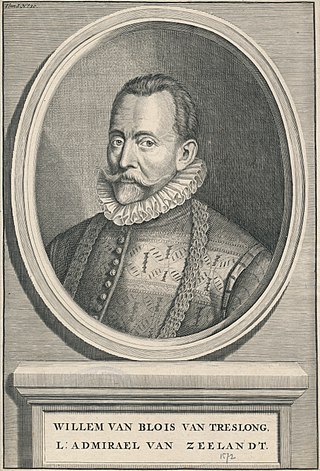
Willem Bloys van Treslong was a nobleman from the Southern Netherlands and military leader during the Dutch war of Independence. He was best known as one of the leaders of the Sea Beggars who captured Den Briel on 1 April 1572.

Jan Pietersz Graeff was an Amsterdam regent and cloth wholesaler from the 16th century.

The Boelens and Boelens Loen were a Dutch patrician family of Amsterdam. The family figured in the city's government lists between the years 1360 and 1680. They were considered to be quite an influential Amsterdam family in their time and were intensely involved in the history of their hometown. Between 1495 and 1538 the oligarchy of the so-called Boelen-Heijnen clan was at the forefront of the Amsterdam city government.
Jan Jacobsz Graeff belonged to the Dutch patrician class, and was a member of the executive board of the Zijpe water board.

The period between the Capture of Brielle and the Pacification of Ghent was an early stage of the Eighty Years' War between the Spanish Empire and groups of rebels in the Habsburg Netherlands.
The Martyrs of Roermond were a group of 13 Dutch Catholic clerics, secular and religious, who were murdered on 23 July 1572 in the town of Roermond by militant Dutch Calvinists during the 16th-century religious wars—specifically, the Dutch Revolt against Spanish rule, which developed into the Eighty Years' War.

Pieter Pietersz Bicker was a Dutch brewer and politician.



















